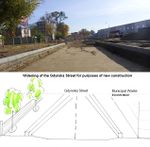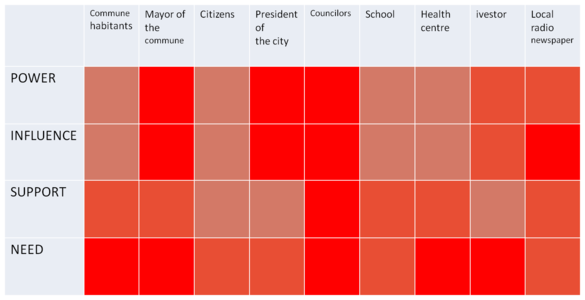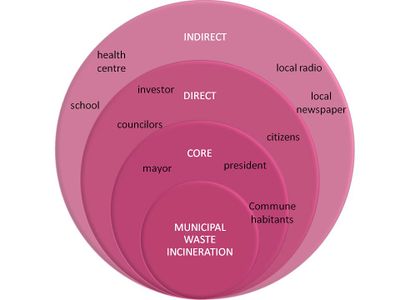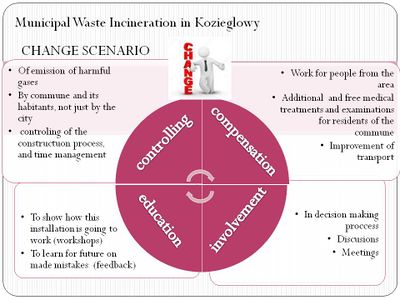Landscape Democracy 2015 Working Group D - Case Study 3
---> back to group page working group D
Municipal Waste Incineration in Kozieglowy
| Place name | Karolin | |
| Location | Kozieglowy, Koziegłowy | |
| Country | Poland | |
| Author(s) | Mirella Rebala | |
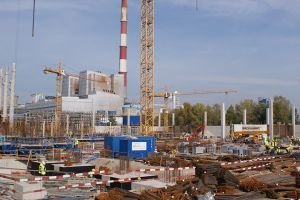
| ||
|
| ||
Rationale: Why have you chosen this case for the landscape and democracy seminar?
The construction of the Municipal Waste Incineration in Koziegłowy, designed for purposes of the whole neighboring metropolis Poznan, is unfortunately negative, although very good example for the landscape and democracy seminar. This case shows failure of the resident decide rights and a victory of political and metropolitan arrangements. Kozieglowy is a town in west Poland with around 11.300 inhabitants, with an overwhelming residential function. It's even called a "bedroom" for people who commute every day between home and work. Unfortunately, the close presence of a big city is not always just advantage. The residents of this suburban area are struggling every day with stench from the Municipal Sewage Treatment plant, which is intended for the purpose of the whole big city. Likewise the power plant, which exists in Karolin settlement since decades. The air pollution and destruction of the landscape definitely disturb residents which are living in this unfortunate place full of contamination. Habitants of Kozieglowy are against the construction of another installation, which will definitely deteriorate environmental conditions of their town. The protests, strikes and letters to the president were unfortunately fruitless. The incineration is for sure needed for the whole urban unit, but why exactly, again, in the place, where all of the environmentally adverse structures already exist? The installation of the municipal waste incineration plant with a capacity of 210 000 tons of waste per year already started. It will be built in the vicinity of the power plant Karolin, in the north-eastern part of the city.
Representation of your observations
- you are basically free to use one or a mix of different presentation techniques
- possibilities are: analytical drawings, graphical representations, collages, video clips, comic/graphic novel, written essay/visual essay
- please add any visual material to the gallery, videos can be placed below, you may add text as you like
- Observations
Reflection
What are the major challenges for changing the situation?
The change of the situation is, in this case, quite difficult to achieve. The construction of the Municipal Waste Incineration in Kozieglowy is already in process. The decision was made by the president of Poznan, who is the main decider in the metropolitan area. Although, in this case the decision should have been made as a jointly cooperation of the president of the city and the major of the commune, which represents the people of the town where the non – environmental friendly construction is going to be build and they are going to be the most vulnerable. If the construction of the waste incineration in this place is unavoidable, would be perhaps necessary to show to the people methods and tools used for this installation. How will this work? Perhaps it’s going to be environmental – friendly? Its necessary to educate people and talk to them, open to discussions and – find the middle way where both sides are going to be glad and happy.
What could be a starting point for democractically-based change?
The starting point for democratically – based change could be, for example, open discussions about the localization oft the environmental non-friendly installations. People must be involved in decision – making process. All the democracy tools can be used in this case. Public meetings, sharing informations, founding communities and work in coalitions - are just few examples of people - powered democracy. From the other side, it's indispensable for authorities to communicate with local people. In this case, although the protest and coalitions were existing, were weak enough to not lead to both sides satisfaction. The construction was imputed to the people who did not agree to this. Still, as a point which can lead to change, see the foundations of communities which are fighting with the situation and not giving up. Writing letters to higher level of government, perhaps even to health ministry. Organisation of meetings where the people can come and get to know about the situation and try to look for solutions together. The most important point is – to listen to the people, their feelings and needs. If the construction makes the group of people uncomfortable, it's necessary to change it.
Stakeholder Mapping
Create a visual representation of the stakeholder groups that are involved in your case. Try to cover the following aspects in your representation: Power (high, medium, low) / Support (positive, neutral, negative)/ Influence (high or low)/ Need (strong, medium, weak)+ also map the relationships between the stakeholder groups
- Stakeholder Engagement map
- Stakeholder map
- Stakeholder Relationships map
Change Scenario
Look at the various methods and tools available and think how they can be applied creatively. Think about the needs of different stakeholder groups - you may need a methodical mix to address them all. Visualize a scenario illustrating how these methods/tools can be applied within an imagined time frame
- Change Scenario
Cross cutting theme
Landscape and democracy case studies must involve a environmental, "natural" side and politic, "human" side as well. Those two factors are also cross cutting themes in discussion about our problems. It is obvious, that for surviving in today's world our civilization needs necessary installations, constructions and infrastructure. Those elements are for landscape artificial, for human - essential. How to solve this "conflict" of interests? The road constructions in protected area, complete change of the use of space or construction of waste incineration in the settlement - those are very controversial and dangerous for landscape (and also human) examples. Why decision can not be make more reasonable and sustainable to avoid drastic results? On the other hand comes human and his "conflict of interests". In all our case studies decisions have been made from the side of "higher instance" and the role of habitants and "normal" people was minimized. Lack of civilian participation can provide to serious danger for the democracy. All this problems perhaps may not be so grave if decisions would have been made based on confrontations with habitants.
Concluding reflections
The place of Waste Incineration is located in Karolin, which is by right still in the border of the city Poznan. In reality, the biggest influence has incineration on the habitants of Kozieglowy and the whole commune Czerwonak. Citizens from Poznan are not complainig, because necessery, although environmentally dangerous facility, is going to stand far away from their houses. Habitants of Czerwonak Commune, who are already suffering under the number of polluting instalations, should get the possibility to get some recouperations.One of them is improvement of the infrastracture and particulary, the roads. The main way leading to Poznan is going to be wider and much friendlier for drivers. Then, the Incineration is also a potencial work possibilty for habitants. Another potencial way of recouperation could be, extra free of costs medical treatments and examinations (eg. against lung diseases). It was already proven, that facilietes in the area of Czerwonak commune are harmful for human body. Limitation is in this case a fact, that's it's impossible to change the plans of the construction. In this case it is neceserry to invest in series of consulations, lectures and workshops which would explain how the Incineration is going to work and let the people understand the whole process. And last, but not least - controlling. Habitants of commune, not the city of Poznan shall be privileged to control emission of gasses and the process of construcion (of the road and also of the incineration). And what is the most important - Inclusion. It is very necessery to let the people involve in the decission making process - referendum, surveys or any other way of showing the opinion is just an example of how the democracy should work.
References
* http://www.fakt.pl/spalarnia-smieci-dostala-pozwolenie-na-budowe,artykuly,444742,1.html'
* http://poznan.naszemiasto.pl/tag/spalarnia-smieci-poznan.html
* http://www.governing.com/columns/smart-mgmt/col-participatory-democracy-emerging-tools.html
* http://www.gloswielkopolski.pl/tag/spalarnia-smieci-poznan.html
* Strategic Environmental Assessment Directive
About categories: You can add more categories with this tag: "", add your categories



